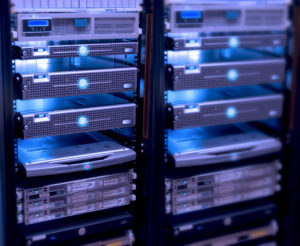Blade Server vs Rack Server
The two most commonly used servers in the data center industry are blade servers and rack servers. This article will serve as a quick start guide to both servers to provide a better understanding of each piece of equipment.
What is a Rack Server?

Rack servers in an EIA 19″ rack
A rack server, or rack-mounted server, is any server that is built specifically to be mounted within a server rack. Rack servers are a general-purpose machine that can be configured to support a wide range of requirements. They are most commonly found in data center environments but can also be used in smaller computer closets. Unlike traditional servers that look much like a PC, a rack server is wider. So it can be secured into the rack using mounting screws or rails, depending on the design. If you only require a small number of servers, they are the best choice economically due to the lower upfront costs.
The height, or the amount of rack units the system might take up, can vary quite a bit. Depending on what is required from the system. Larger servers allow for additional CPUs, memory, or other components. The servers themselves are mounted one on top of the other within a rack. To help minimize the amount of space used.
Benefits of a Rack Server
While which type of server you use largely depends on the scenario, there are several advantages of using a smaller rack server over a blade server:
- Power – Rack servers are typically built with all the needed components to operate as a stand-alone system. They can be very powerful and are used to run high end applications.
- Convenience – Having the ability to easily mount a server within a rack is convenient and saves a lot of space, especially when compared to a traditional tower style server.
- Cooling – Cooling a rack server is easier than most others. They are usually equipped with internal fans and placing them in a rack increases airflow.
- Ideal for Lower Quantity – Rack servers are best suited when you need more than one server (but less than about 10) because they don’t require a massive chassis.
What is a Blade Server?

A blade server is a modular server that allows multiple servers to be housed in a smaller area. These servers are physically thin and typically only have CPUs, memory, integrated network controllers, and sometimes storage drives built in. Any video cards or other components that are needed will be facilitated by the server chassis. Which is where the blades slide into. Blade servers are often seen in large data centers. Due to their ability to fit so many servers into one single rack and their ability to provide a high processing power.
In most cases, one large chassis such as HPE’s BladeSystem will be mounted into a server rack and then multiple blade servers slide into the chassis. The chassis can then provide the power, manage networking, and more. This allows each blade server to operate more efficiently and requires fewer internal components.
Blade servers are generally used when there is a high computing requirement with some type of Enterprise Storage System: Network Attached Storage (NAS) or a Storage Area Network (SAN). They maximize available space by providing the highest processor per RU availability. Blade Servers also provide rapid serviceability by allowing components to be swapped out without taking the machine offline. You will be able to scale to a much higher processor density using the Blade architecture. The facility will need to support a much higher thermal and electrical load per square foot.
Benefits of a Blade Server
- Power Consumption – In many cases the chassis for the Blade Server will supply the power to multiple servers, reducing total consumption.
- Hot Swappable – Blade servers can be configured to be hot swappable so if one blade has a problem, it can be pulled and replaced much more easily. This helps to facilitate redundancy.
- Less Need for Cables – Rather than having to run individual cables for each server, blade servers can have one cable (often fiber) run to the chassis, thus reducing the total cable requirements.
- Processing Power – Blade Servers can provide an extremely high processing power while taking up minimal space
Bottom Line
When to use a rack server or a blade server depends entirely on each scenario. Ultimately, both a Blade Server and a Rack server can be configured to do the same work. It all boils down to which one can do the work most economically. Based on your processing needs and the layout of your space. Be sure to take into consideration the thermal and electrical requirements of your machine (plate rating), computing requirements of the work (CPU/hr.), and the carrying capacity of the facility (Watts/sq. ft.) when trying to find the optimal server for your needs.
Source:RackSolution
Recent Posts
-
Anker’s first 3D printer is up for preorder
As the first Kickstarter backers received their AnkerMake units and started looking into the softwar …Jan 29th 2024 -
The business of hackers for hire threat actors
Cybercrime has entered a new era where people don't steal just for the thrill of doing it anymore.To …Jan 29th 2024 -
Tumblr’s only viable business model is shitposting
As Elon Musk struggles to make people give Twitter $8 a month for a blue check, Tumblr had an idea: …Jan 29th 2024



